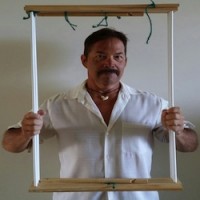
I’ve come to an appreciation of the concept of alignment.
I hear that word often in class and my teachers speak of it in relationship to posture and precision. They hope and beg us to arrange our limbs and spines according to predetermined positions for maximum flexibility, fullness of breath and improved posture.
Outside of class, I read about the importance of alignment, and I’ve come to believe that a keen appreciation of alignment can be a perspective-changer.
If I truly live an alignment which is inclusive, my behavior will match my beliefs and my movements will be fluid and stress-free.
Think of a misaligned car: the tires wear unevenly, the frame weakens from extra vibrational stress and the steering doesn’t feel right.
To get a feel for misalignment and how it might play out in your life, try walking in a straight line toward a point on the wall across the room. But rather than walking normally, walk with your feet turned out to the side at a 45 degree angle while keeping your chest aimed directly ahead toward that point on the wall.
The human body will rebel at this contorted position because it is misaligned; steps are not coordinated with fluid hip flexing, body and mind are stressed beyond a normal, natural gate.
I’ve performed this experiment to remind myself that I am working on alignment in movement and in everything I do. Like much of what we do in yoga, my awareness of alignment starts with breathing. It is my main goal these days to regulate deep and slow breaths in deliberate sequence and in concert with my rising and falling diaphragm.
Good alignment is not divorced from ethics or behavior. This reflection has taught me to think through my money ethic. If I don’t really care about material abundance or spending money at expensive restaurants, then I won’t care about having great piles of money because I won’t need it.
And if my living situation puts me into a job that is stressful because I think I need money, yet if it’s really not true to my deeper values, then I would be in misalignment with the power of money and the stress it causes in my life. I would not be aligned with my true values.
Reflection on the meaning of alignment has brought a change to my personal habits. Early in my practice, I frequently drank alcohol in the evening. I didn’t think much about it, I just did so out of habit and ignorance.
After a while, though, I realized that I didn’t really want nor need alcohol.
It was foolish to consciously hydrate myself during the day for my practice, but then turn around and dehydrate myself at night by drinking. I realized that it didn’t make any sense and that drinking was not in alignment with what I really wanted.
Ruminating on alignment has opened up new thoughts: I’ve learned through journalling to evaluate alignment in relationship to my geography and my posture.
Alignment in geography means I am living in a place that is parallel to my preferences.
If I am in tune with my living space, the choices I’ve made have put me in a country environment or a city environment, a hot or a cold climate, a slow-paced or fast-paced populace based on what I comfortably affiliate and agree with.
For me, that’s Hawaii. I grew up in the cold country of Wisconsin, and for many years I struggled to be comfortable there. I found my back tightening from the cold and I ached as I hunched over while walking on ice. I didn’t like it and finally made a big move to assure that I would live in a place better aligned with what I do like … hot weather.
In my daily life, I’ve noticed better alignment in my posture.
I no longer sit with legs crossed. I walk with my spine erect and no longer slouch on a soft chair. I keep my limbs uncrossed and my hands open to facilitate a free-flowing movement of ch’i. I’ve also noticed the more aligned and open my posture, the better I feel.
These thoughts bring me back to remembering an experiment I participated in during graduate school. Our professor asked the class to stand up and walk around the room while embodying as closed and guarded posture as we could possibly mimic. We went on like this for five minutes, walking around the room in defensive mode. Nobody spoke, few made eye-contact.
Then he stopped us, and asked that we switch our posture to one of openness by standing straight, arms positioned at our sides, head up and smiling. We walked around the room for five minutes like this. Some people chatted; I heard laughter, the room warmed.
After we took our seats, we commenced with discussion of what each posture felt like in our bodies as we embodied closed and defensive versus open and welcoming. The discussion was an enlightening lesson on the alignment of posture and bodily messaging.
As I check my alignment, I release my foot from the brake and open-up the ch’i. Perhaps an alignment check is part of your next project.
Love elephant and want to go steady?
Sign up for our (curated) daily and weekly newsletters!
Editor: Renée Picard
Image: Markus Gann at Pixoto








Read 0 comments and reply